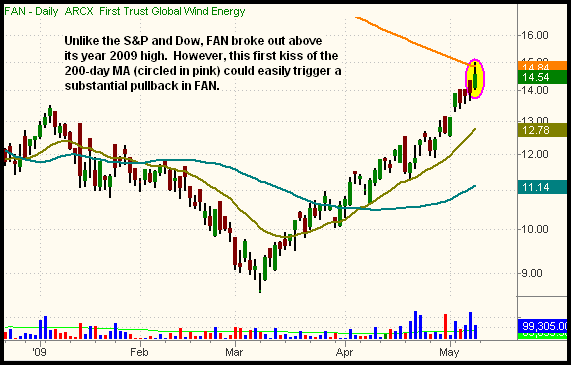|
The Wagner Daily ETF Report For May 11
The major indices closed the week with a bounce back from the previous day's losses, but the Nasdaq continued to show clear relative weakness. After gapping higher on the open, stocks sold off for the first hour of trading, but the bulls returned at mid-day, lifting the main stock market indexes to substantial gains by the close. The S&P 500 gained 2.4%, the Dow Jones Industrial Average 2.0%, and the Nasdaq Composite 1.3%. After falling 2.4% on Thursday, the Nasdaq Composite's brother, the large-cap Nasdaq 100, showed bearish divergence by edging just 0.3% higher. Small and mid-cap stocks, however, perked up. The Russell 2000 and S&P Midcap 400 indices jumped 3.8% and 3.4% respectively. The S&P 500 and Dow Jones Industrials closed at their best levels of the day and week. The Nasdaq Composite closed near the middle of its intra-week range, but still managed to log its ninth consecutive weekly gain.
Lower turnover was the one negative of Friday's rally. In the NYSE, total volume was 5% lighter than the previous day's level. Total volume in the Nasdaq eased 2%. In the previous session, all the main stock market indexes sold off on higher volume, registering "distribution days" in both the S&P 500 and Nasdaq. As such, it would have been much better if higher volume accompanied Friday's recovery, but that wasn't the case. Nevertheless, advancing volume in the NYSE exceeded declining volume by more than 7 to 1. Nasdaq internals, not surprisingly, were less positive. Advancing volume beat declining volume by less than 2 to 1.
Although stocks scored another round of gains last week, substantial price divergence within the broad market was observed, particularly in the latter half of the week. Last Wednesday, the Nasdaq Composite exhibited signs of "churning," as volume surged to its highest level in five months, but price was little changed. The following day, turnover spiked even higher, and the Nasdaq fell more than 2%. Conversely, a positive reaction to last week's results of the financial "stress tests" led to a positive reaction in the financial sector and ETFs, helping the S&P 500 and Dow Jones Industrial Average to outperform the Nasdaq. However, because sustainably strong markets need to be driven by leading sectors and stocks, not dead industries merely bouncing off their lows, we do NOT view it as positive that financials have been one of the best-performing sectors in the current stock market rally.
As we enter the new week, the Nasdaq is sitting just below its 200-day moving average; it has closed below it in each of the past two sessions. Despite efforts by the S&P and Dow to ignore the recent relative weakness in the Nasdaq, we believe further weakness in the Nasdaq this week would have a very high chance of weighing down the rest of the main stock market indexes as well. But a decent pullback in the market would actually be most welcome at this point, as it would provide us with the opportunity to enter the strongest ETFs on retracements to new support levels.
Last week, we pointed out the strength in the Emerging Markets and Solar Energy ETFs, and we continue to look for pullback entries in these sectors. Another ETF with relative strength to the broad market is First Trust Global Wind Energy (FAN). Its daily chart is shown below:

The S&P 500 and Dow Jones Industrial Average are still below their January 2009 highs. FAN, however, already broke out above its January 2009 highs last week, and is now testing its 200-day moving average. If this first touch of the 200-day MA leads to a pullback, we'd initially look to buy FAN near support of the 20-day exponential moving average. If a retracement turns out to be steeper than the 20-day EMA, the 50-day moving average, presently at the $11.14 area, would provide a secondary buy entry.
U.S. Natural Gas Fund (UNG), a short-term trend reversal play we're positioned in, cruised more than 4% higher last Friday. It has also closed higher in six of the past seven days. Volume has been more than 300% its average daily level in each of the past two days, indicating real accumulation on behalf of mutual funds, hedge funds, and other institutions. In addition to UNG, a handful of other commodity ETFs turned in strong performances as well. The crude oil ETFs all broke out above prior resistance of their March 2009 highs. SPDR Gold Trust (GLD) moved back above its 50-day MA. The iShares Silver Trust (SLV), another of our open positions, is fast-approaching this year's high. If the U.S. dollar continues to soften, commodity ETFs could become the next leaders in the intermediate-term.
Open ETF positions:
Long - UNG, SLV, FXY
Short - (none)
Deron Wagner is the Founder and Head Trader of both Morpheus Capital LP, a U.S. hedge fund, and MorpheusTrading.com, a trader education firm.
|